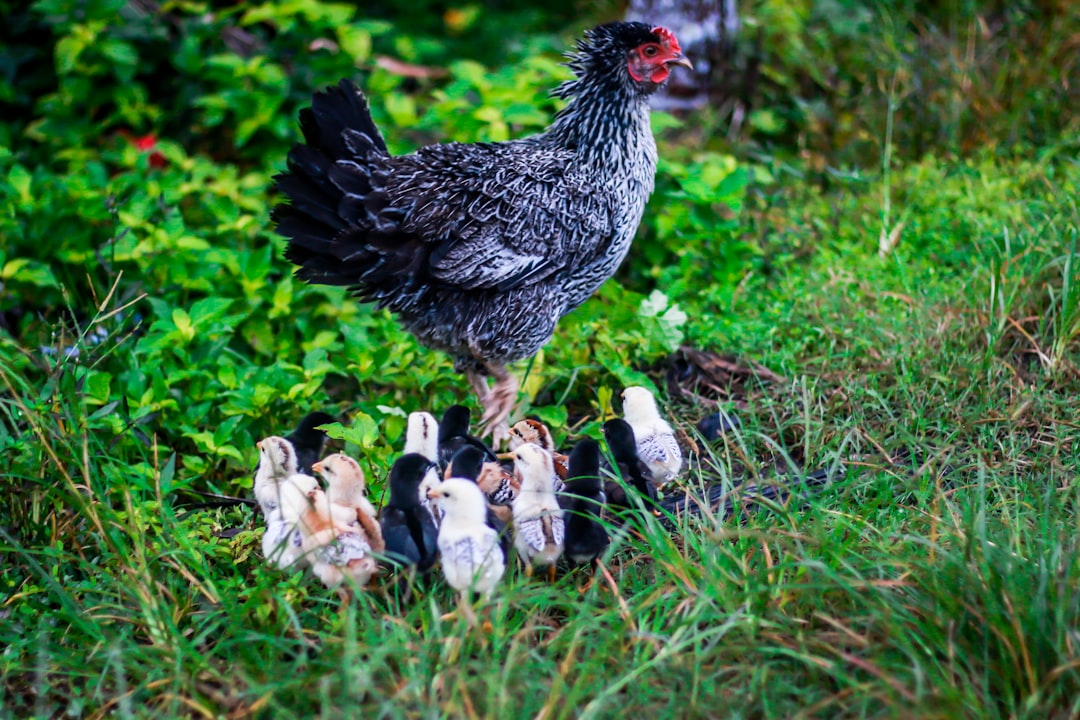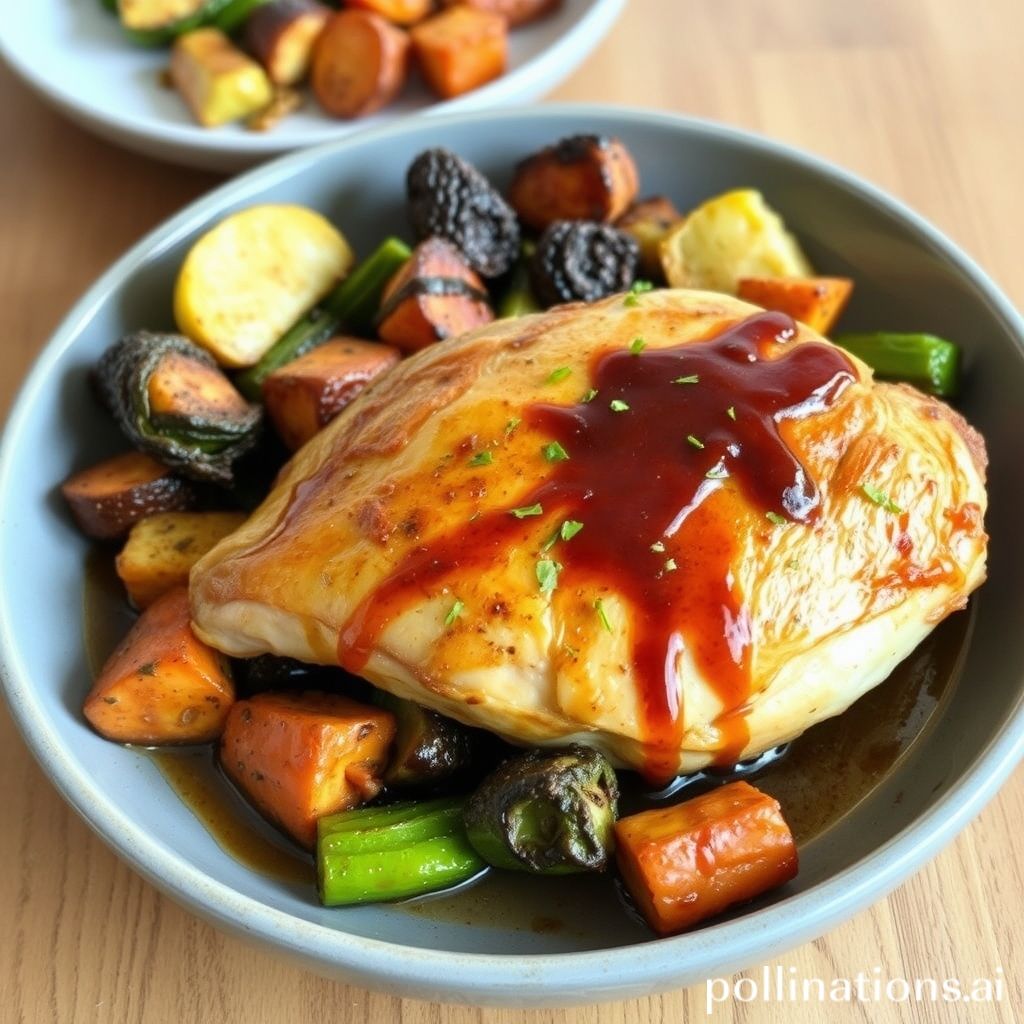Table of Contents
- Introduction
- Ingredients and their roles: Chicken thighs, balsamic vinegar, honey, dijon mustard, garlic, thyme, rosemary, Brussels sprouts, carrots, red onion, olive oil, salt, and black pepper
- Preparation steps for Balsamic Glazed Chicken
- Tips for perfectly roasted vegetables
- Combining and cooking techniques for ideal flavor fusion
- Nutritional benefits and serving suggestions
- Substitutes and variations: Different types of chicken, alternative vegetables, and other glaze options
- Pairing with side dishes and wines
- Storage and reheating tips for leftovers
- Conclusion
- Frequently Asked Questions
Introduction
Welcome to a culinary journey where you’ll discover the magic of creating a dish that’s both simple and elegant: Balsamic Glazed Chicken with Roasted Vegetables. Imagine tender chicken breasts glazed with rich, tangy balsamic vinegar, caramelized to perfection, and paired with a medley of roasted vegetables that sing with natural sweetness and savory charm. This meal doesn’t just promise wonderful flavors but also brings joy to your kitchen, transforming dinner into a delightful experience.
As you embark on this delicious adventure, gather the following ingredients:
- 4 boneless, skinless chicken breasts
- 1/2 cup balsamic vinegar
- 2 tablespoons honey
- 3 cloves garlic, minced
- 1 teaspoon dried thyme
- 1 teaspoon dried rosemary
- Salt and pepper to taste
- 2 cups baby carrots
- 2 cups Brussels sprouts, halved
- 1 red onion, cut into wedges
- 2 tablespoons olive oil
Get ready to create a meal that will become a staple in your culinary repertoire. Each ingredient in this recipe plays a crucial role in building layers of flavor and texture, ensuring that every bite is a celebration of taste. Whether you’re preparing a weeknight dinner or a special occasion, this dish is designed to impress and satisfy.
Ingredients and their roles: Chicken thighs, balsamic vinegar, honey, dijon mustard, garlic, thyme, rosemary, Brussels sprouts, carrots, red onion, olive oil, salt, and black pepper
The ingredients for balsamic glazed chicken with roasted vegetables play crucial roles in creating a flavorful and balanced dish. Chicken thighs are used for their rich taste and tenderness, providing a satisfying base protein. Balsamic vinegar adds a tangy and slightly sweet depth, while honey balances this with its natural sweetness. Dijon mustard introduces a slight sharpness and complexity to the glaze, and garlic infuses a savory, aromatic undertone.
Thyme and rosemary are essential herbs that lend an earthy and fragrant aroma, enhancing the overall flavor profile. When it comes to the vegetables, Brussels sprouts bring a hearty and slightly bitter taste, while carrots add a touch of natural sweetness. Red onion contributes a mild, yet distinct, sharpness and sweetness. Olive oil is used to roast the vegetables, ensuring they become tender and caramelized, while salt and black pepper are fundamental for seasoning, bringing all the flavors together for a cohesive dish.
Preparation steps for Balsamic Glazed Chicken
To prepare Balsamic Glazed Chicken with Roasted Vegetables, start by preheating your oven to 400°F (200°C).
Next, prepare the chicken breasts by seasoning them with salt, pepper, and a sprinkle of garlic powder.
In a small bowl, mix together balsamic vinegar, honey, Dijon mustard, and minced garlic to create the glaze.
Place the chicken breasts in a baking dish and generously brush them with the balsamic glaze. Let them marinate for at least 15 minutes to absorb the flavors.
Meanwhile, chop your favorite vegetables such as carrots, bell peppers, zucchini, and red onions into bite-sized pieces and place them on a baking sheet. Drizzle them with olive oil, season with salt and pepper, and toss to coat evenly.
Place both the baking dish with chicken and the baking sheet with vegetables in the preheated oven. Roast the chicken for about 25-30 minutes, or until it reaches an internal temperature of 165°F (74°C).
Roast the vegetables for about 20-25 minutes, or until they are tender and slightly caramelized.
Once cooked, remove from the oven and let the chicken rest for a few minutes before slicing. Serve the balsamic glazed chicken alongside the roasted vegetables for a delicious and balanced meal.
Tips for perfectly roasted vegetables
Roasting vegetables to perfection can elevate your dishes and bring out the natural flavors. Here are some tips to help you achieve perfectly roasted vegetables every time.
1. Cut Evenly: Make sure to cut your vegetables into uniform sizes to ensure they cook evenly. Smaller pieces will roast faster, so keep this in mind when preparing.
2. Preheat Your Oven: A hot oven is essential for roasting vegetables. Preheat your oven to 425°F (220°C) to get that beautiful, caramelized exterior.
3. Use the Right Oil: Coat your vegetables lightly with high-smoke-point oils like olive oil or avocado oil. This helps in achieving a crispy texture.
4. Don’t Overcrowd: Spread your vegetables in a single layer on a baking sheet. Overcrowding leads to steaming instead of roasting, resulting in a soggy texture.
5. Season Well: Generously season your vegetables with salt, pepper, and your favorite herbs and spices. This enhances their flavor and adds depth to the dish.
By following these tips, you’ll end up with deliciously roasted vegetables that complement your Balsamic Glazed Chicken perfectly.
Combining and cooking techniques for ideal flavor fusion
Combining and cooking techniques are essential for achieving the ideal flavor fusion in Balsamic Glazed Chicken with Roasted Vegetables. Start by marinating the chicken in a mixture of balsamic vinegar, olive oil, garlic, honey, and fresh herbs. This not only infuses the meat with a rich, tangy flavor but also tenderizes it, ensuring a juicy and flavorful result. While the chicken marinates, prepare the vegetables, such as bell peppers, zucchini, carrots, and red onions, by cutting them into uniform pieces for even roasting. Toss the vegetables in olive oil, salt, and pepper, allowing them to enhance their natural flavors as they caramelize in the oven.
To cook, preheat the oven to 400°F (200°C). Place the marinated chicken on a baking sheet, arranging the vegetables around it. This allows the flavors to meld together as they cook. Roast for about 25-30 minutes or until the chicken reaches an internal temperature of 165°F (74°C) and the vegetables are tender and slightly charred. The balsamic glaze thickens and forms a delicious coating on the chicken, while the roasted vegetables offer a perfect balance of sweetness and texture. This combination of marinating, roasting, and glaze application ensures a harmonious blend of flavors in every bite.
Nutritional benefits and serving suggestions
Balsamic glazed chicken with roasted vegetables is not only a delicious meal but also packed with nutritional benefits. The chicken provides a high-quality source of lean protein, essential for muscle repair and growth. Balsamic vinegar, used in the glaze, contains antioxidants that help combat inflammation and lower cholesterol levels.
Roasting vegetables like bell peppers, zucchini, and carrots enhances their natural flavors while preserving their vital nutrients, such as vitamins A and C, fiber, and potassium. These nutrients play a crucial role in maintaining good vision, immune function, and overall digestive health.
Serving suggestions for this dish are versatile. It pairs wonderfully with a side of quinoa or brown rice for added complex carbohydrates and fiber, making it a well-rounded meal. Alternatively, a fresh garden salad can complement the richness of the balsamic glaze while keeping the meal light. For an extra touch, sprinkle some fresh herbs like basil or parsley just before serving. This addition not only elevates the flavor but also adds a touch of freshness to the dish.
Substitutes and variations: Different types of chicken, alternative vegetables, and other glaze options
When preparing Balsamic Glazed Chicken with Roasted Vegetables, there are plenty of opportunities to customize the dish to your taste. For different types of chicken, you can use chicken thighs, drumsticks, or even a whole chicken cut into pieces instead of the standard chicken breasts. Each cut offers a unique texture and flavor profile, allowing you to find your preferred option.
As for the vegetables, the sky’s the limit. While the classic recipe might include bell peppers, zucchini, and onions, feel free to experiment with other options like sweet potatoes, Brussels sprouts, or carrots. These alternatives not only add different textures but also enhance the dish’s nutritional value.
When it comes to the glaze, balsamic vinegar pairs wonderfully with honey or brown sugar for a sweet and tangy finish. However, you can try other glaze options such as teriyaki sauce, honey mustard, or even a lemon herb dressing for a lighter, citrusy touch. The key is to balance the flavors so that the chicken and vegetables complement each other harmoniously. Enjoy experimenting with these substitutes and variations to make the dish truly your own.
Pairing with side dishes and wines
When it comes to pairing Balsamic Glazed Chicken with Roasted Vegetables, selecting the right side dishes and wines can enhance the overall dining experience. One excellent side dish to complement the rich flavors of balsamic glaze is creamy mashed potatoes. Their smooth texture and buttery taste provide a delightful contrast to the savory chicken and roasted vegetables. Another great option is a crisp, fresh salad with a light vinaigrette dressing to balance the dish’s richness.
As for wine, a medium-bodied red like Pinot Noir works wonderfully with Balsamic Glazed Chicken. Its fruity notes and subtle earthiness harmonize beautifully with the balsamic glaze and roasted vegetables. Alternatively, a Sauvignon Blanc with its zesty acidity and hints of citrus can also be a great match, cutting through the richness and adding a refreshing element to the meal. These pairings not only elevate the flavors but also create a well-rounded and memorable dining experience.
Storage and reheating tips for leftovers
Storing and reheating leftovers of Balsamic Glazed Chicken with Roasted Vegetables can help you make the most out of your meal. To store leftovers, place the chicken and vegetables in an airtight container and refrigerate them within two hours of cooking. Properly stored, the leftovers can last up to 3-4 days in the refrigerator.
To reheat, you can use either a microwave or an oven. For the microwave, place the chicken and vegetables on a microwave-safe plate, cover with a microwave-safe lid or wrap, and heat on high for 1-2 minutes or until warmed through. Stir the vegetables halfway to ensure even heating.
If you prefer to use an oven, preheat it to 350°F (175°C). Place the chicken and vegetables in an oven-safe dish and cover with aluminum foil to prevent drying out. Reheat for about 15-20 minutes or until the internal temperature reaches 165°F (75°C). Stir the vegetables occasionally for even heating. Serving the reheated dish with a fresh drizzle of balsamic glaze can help revive the flavors.
Conclusion
Savoring the delightful flavors of Balsamic Glazed Chicken with Roasted Vegetables not only offers a gourmet dining experience but also brings myriad nutritional benefits to your table. By following the simple steps and incorporating the expert tips shared in this article, you can effortlessly prepare a balanced, delicious meal that is sure to impress. Whether you’re new to cooking or a seasoned chef, this recipe offers an adaptable foundation for culinary creativity.
For those who crave more chicken recipes to diversify their meal repertoire, consider adding The Chicken Bible: Say Goodbye to Boring Chicken with 500 Recipes for Easy Dinners, Braises, Wings, Stir-Fries, and So Much More to your cookbook collection. This comprehensive guide will inspire you with countless ways to transform chicken into mouthwatering dishes. Purchase your copy today and take your chicken cooking to the next level!

